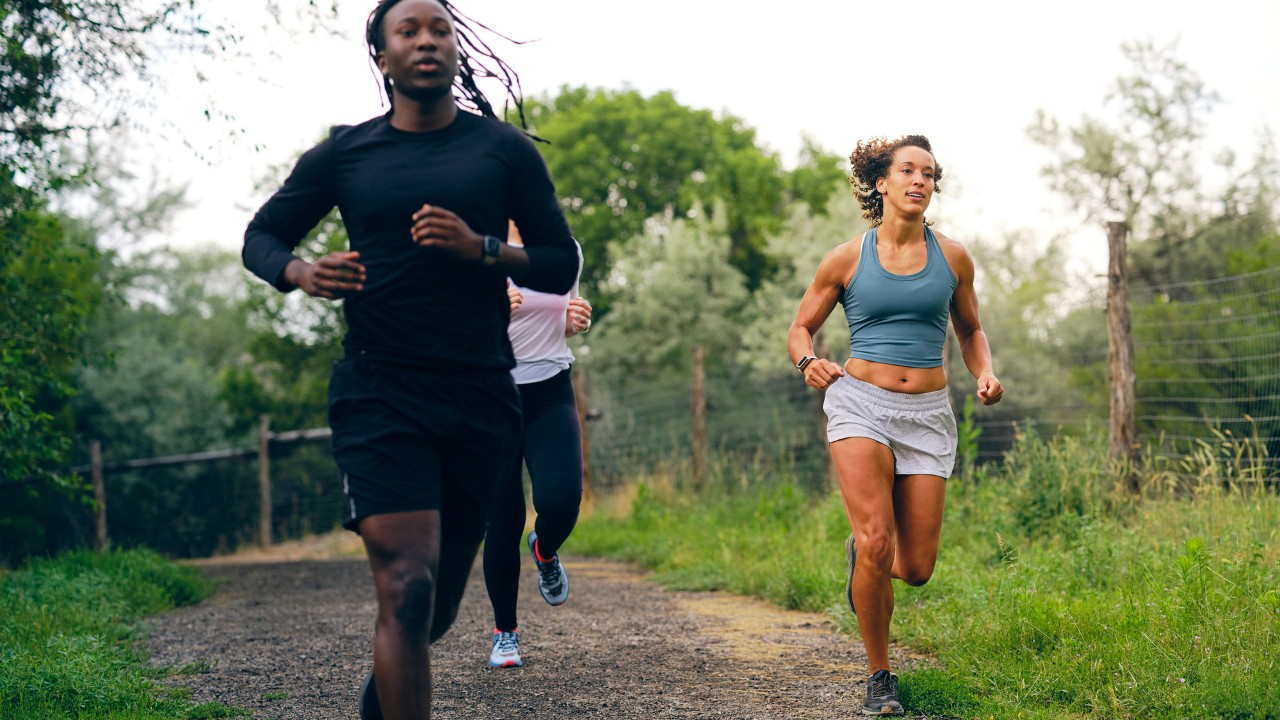All Of Your Long Run Questions Answered
Everything you need to know about long runs, including the benefits and how best to go about them

There are some types of runs that you come across where even the basics can be tricky to understand, like threshold or tempo runs. Others are easier to get a handle on, like interval running and indeed long runs, because most of us understand that the latter involve running for a longer distance or period of time than normal.
However, there’s a lot to learn beyond the basics of long runs to make sure you’re doing them right, and if you are following a marathon or half marathon training plan it’s essential that you nail your long runs to be prepared for race day.
To answer any questions about long runs you might have, with a focus on long runs as part of marathon training, we spoke to running coach and Saucony ambassador Nick Anderson, who’s also the founder of runningwithus.com, a team of experienced coaches.
What are the benefits of long runs?
From a purely physiological point of view, they build aerobic fitness: more red blood cells, greater capillarisation in the muscles, mitochondria get stronger – all providing you’re running slowly and sensibly.
You also teach your body to use energy cleverly. Have a good pre-long-run breakfast and eat well in the days before, then go out at a slower pace to make sure you’re burning fatty acids in your bloodstream at the same time as burning your glycogen stores. If you run too fast, you’ll only burn carbohydrates [glycogen]. If you run at a sensible pace, you’ll burn both of those more effectively, so you’ll spread the amount of time that your glycogen stores provide energy for you.
How long should a long run in a marathon training plan be?
Most marathon training plans assume you can already run up to 5K in training, so build gradually from there. If you can run for about 90 minutes to two hours when you’re 10 to 12 weeks out from the marathon, whether it’s walk/running or easy running, you’re in a very good place.
You shouldn’t be looking to cover the full distance in marathon training in your long run. A few elite athletes will do it, but most don’t. Your long run is developing the ability to spend a long time on your feet to make the distance achievable.
For your longest long run – how long is a piece of string? It’s different for everyone, but somewhere between 16 and 22 miles. I say that because your longest run in marathon training, which might be three or four weeks before the race, shouldn’t be much longer than about 3½ hours. Any longer and you struggle to recover from that training run and then three or four weeks later, you’re still tired.
A newer runner who’s perhaps taking five to six hours to run a marathon might only get to 16 or 17 miles in training. They may panic but the reality is, with all of the other training, they will be great on the day.

Should you still do long runs if you’re not training for a marathon?
I’m working with lots of different types of runners and the long run is still a key component. You should keep in touch with your longer long runs throughout the year, but not be doing loads of them. So if you’re a marathon runner who’s going into a period of 5K, 10K work, you’re probably looking more towards 90 minutes for your long run, but every now and then going up to two hours just to keep in touch with that kind of endurance.
Generally, a long run of 80-90 minutes for anyone who’s training for 5K, or even shorter distances on the track, is good. It builds more red blood cells, it builds the foundations of endurance. A 1,500m race is still an endurance event. It’s just that you run very quickly.
How fast should you run your long runs?
I think most runners run their longer runs too hard in the early weeks of training. They go out and do their normal run pace and just do it for longer. That’s doing two bad things. First of all it’s causing more damage for a longer period of time. And we don’t want that. And the second thing is it’s not educating our body to become better fat-adapted. So the slower we run, the better we’re going to get at working with fats and carbohydrates.
If you’re an experienced runner, slow down to 30, 45 or maybe even 60 to 90 seconds per mile slower than your planned marathon pace in your long runs.
For the not-so-experienced runner I always say run at the speed of chat. If you can’t talk easily, you’re working too hard and you’re burning too much carbohydrate, rather than stored fats and carbohydrates at the same time.
In the final 10 to 12 weeks, the runner who’s got a target or is very experienced can start to build in blocks at marathon pace into their long run. Maybe put some marathon pace in during the second half of your long run, because you’ve got to get better at working harder like you will in the second half on marathon day.
You can also consider progression runs where the pace will gradually build in the long run because on marathon day you’re going to have to gradually work harder to maintain the same pace. You could even start to put some blocks in that are slightly harder than marathon pace.
Whatever you do, I think you should line up on event day having done a number of reps in the last 10 to 12 weeks where you have practised your marathon pace. If you’re a target runner who’s going for a time you should stand there confident you can hold this pace and really believe it.
What and when should you eat before a long run?
It’s so personal. I’ve seen the world’s best athletes eat porridge, bananas, bagels, energy bars and stuff like that. Use whatever is going to give you a really good amount of carbohydrate that you can easily digest and sits comfortably. I used to sometimes have a plain bowl of pasta for breakfast, because it’s just a lump of fuel that’s going to give you energy.
What you don’t want to do is just copy what someone else is doing and then bail out to the loo because there’s too much fibre. Porridge might be an issue where it’s fine for others. Make sure you’re comfortable with it and try it in all of your long runs.
Also I think a big mistake people make is they focus on the breakfast, but they haven’t thought about what they had to eat the night before and probably the afternoon before. One of the reasons you might suffer with gut issues could not be the breakfast, but actually because there was too much fibre, perhaps too many vegetables, and too much protein in the meal you had in the afternoon or the evening before.
I would look at more beige, bland carbohydrates that are easy to digest, reducing the amount of protein and just a very light amount of vegetables the afternoon and night before as well. So everything’s very settled. It’s very boring. It’s just fuel.
How do you fuel during a long run?
I work on the basis that a gel every 30 to 45 minutes is probably as much as your gut will tolerate. Some people can do a bit more. The biggest mistake people make is they forget the enzymes in the gut are already very, very irritated because you’re bouncing up and down as you run. You’re going through lots of different processes that enzymes are having to deal with metabolically as you’re running. Then you introduce a load of sugar to the gut – and quite often people whack the gel down like it’s a Jägerbomb – and suddenly 40g of carbohydrate is hitting the stomach wall and the body can’t deal with it. Also, it’s not going to absorb all of it.
The side effects of that are stomach ache, needing to go to the loo, feeling nauseated. The best thing you could do is to sip on a gel and take five to 10 minutes to finish it. Then the absorption rates are higher.
A lot of physiologists and dietitians will talk about you being able to absorb about 60g of carbohydrate an hour while you’re performing. I would argue that that’s OK if you’re very much in control. For athletes really pushing hard and getting nearer to the top end of their threshold zone, what you can take on and tolerate gets harder and harder to do, which is why a lot of elite athletes tend to use liquid sports drinks because they’re easier to take on than gels.
When you are a newer runner, you’re going to be working hard, but your heart rate will be a bit lower and it should be easier for you to take on your gels and manage that whole process. So it becomes a game of how much you can take in an hour that’s comfortable. You might start to get nearer to 60g which is a good thing because you’re going to be out for longer.

How much water should you drink on a long run?
I’m a fan of drinking to thirst or just ahead of it. I think people can comfort drink when there’s drink stations every mile in the major city marathons. The reality is if you drink to thirst, it’s better.
Water is fantastic, but to hydrate when performing consider adding things like electrolyte tablets that are going to have more sodium, potassium, magnesium in them, without sugar. It’s going to turn your water into something that the enzymes are more interested in. So the absorption rates are higher and hydration rates are better.
It’s better to drink little and often of those drinks than to drink lots of water, which eventually doesn’t have the right effect, particularly when it’s warmer. And in extreme cases when you drink too much water, it can induce hyponatremia.
Should you try to replicate marathon conditions in your long runs?
I occasionally get messages from some of my more serious runners saying they struggled to hit marathon pace today. So we look at it and usually find the profile of the route was wrong. It was undulating or hilly, or they were running into the wind during the marathon pace section. Or a large part of that run was hard before the marathon pace segment so they were already too tired by the time they got there.
I think when you get to your key runs, that’s where you’ve got to make it a really good surface. A good road in a quiet area, so you’re not stopping and starting crossing roads. Think about the wind direction a little bit. Make it totally achievable for your marathon pace so it feels controlled.
When you go out and just run easy or steady, then those runs can be off-road and/or undulating, it’s probably good for you to keep you strong.
Should you use your marathon shoes during long runs in training?
It’s really relevant at the moment because of the super-shoe situation. I see a lot of runners doing long runs in the wrong shoes. At some stage in your final 10 weeks, if you’re going to wear a carbon plate shoe like the Saucony Endorphin Pro 3 on race day, then you need to do a few long runs in that shoe. You’ve got to become efficient at running in that shoe at marathon pace for up to two hours and beyond. You’ve got to have gone up to 30km in your marathon choice of shoe and know it’s still comfortable, because it’s what happens after 20km that will determine whether that shoe will work for you.
How do you recover after a long run?
Focus on nutrition when you get back. Start with a recovery drink, whether it’s your own designed milkshake, or a sports drink with electrolytes, protein and carbs in it.
At some stage on the day after it’s good to stretch or foam roll and I think you should go for a walk to get everything moving again. The improved circulation from that then speeds up recovery. Some people will use compression garments and different extreme recovery processes. They work, so consider that as well. If you want an ice bath, there seems to be some evidence they have an effect but I will say you’re quite brave!
The longer your long run, the longer you take to recover. Make sure the next day or two are easy. I would never advise doing a harder training session the day after a long run. I see a lot of people doing a long run on Sunday, then they’re at the club on a Tuesday trying to run hard and wondering why the session is not going well. They’re picking up injuries or illnesses, particularly injuries. You’re very susceptible to injuries in the day or two after your long run.
Sleep well, get your energy levels back up, and be prepared to move your next good-quality session or run later in the week that follows.
How To Nail Your Recovery After A Long Run
- Use This Running Recovery Routine After A Run To Help You Recover Faster
- Use Laura Muir’s Recovery Smoothie Recipe To Refuel After Your Toughest Runs
- Stretches For Runners To Help Speed Up Your Recovery
- Use These Post-Run Stretches To Recover After Your Training
- Stretch Your Aching Muscles With This Post-Run Yoga Routine
- Essential Foam Rolling Exercises For Runners
Get the Coach Newsletter
Sign up for workout ideas, training advice, reviews of the latest gear and more.

Nick Harris-Fry is a journalist who has been covering health and fitness since 2015. Nick is an avid runner, covering 70-110km a week, which gives him ample opportunity to test a wide range of running shoes and running gear. He is also the chief tester for fitness trackers and running watches, treadmills and exercise bikes, and workout headphones.









